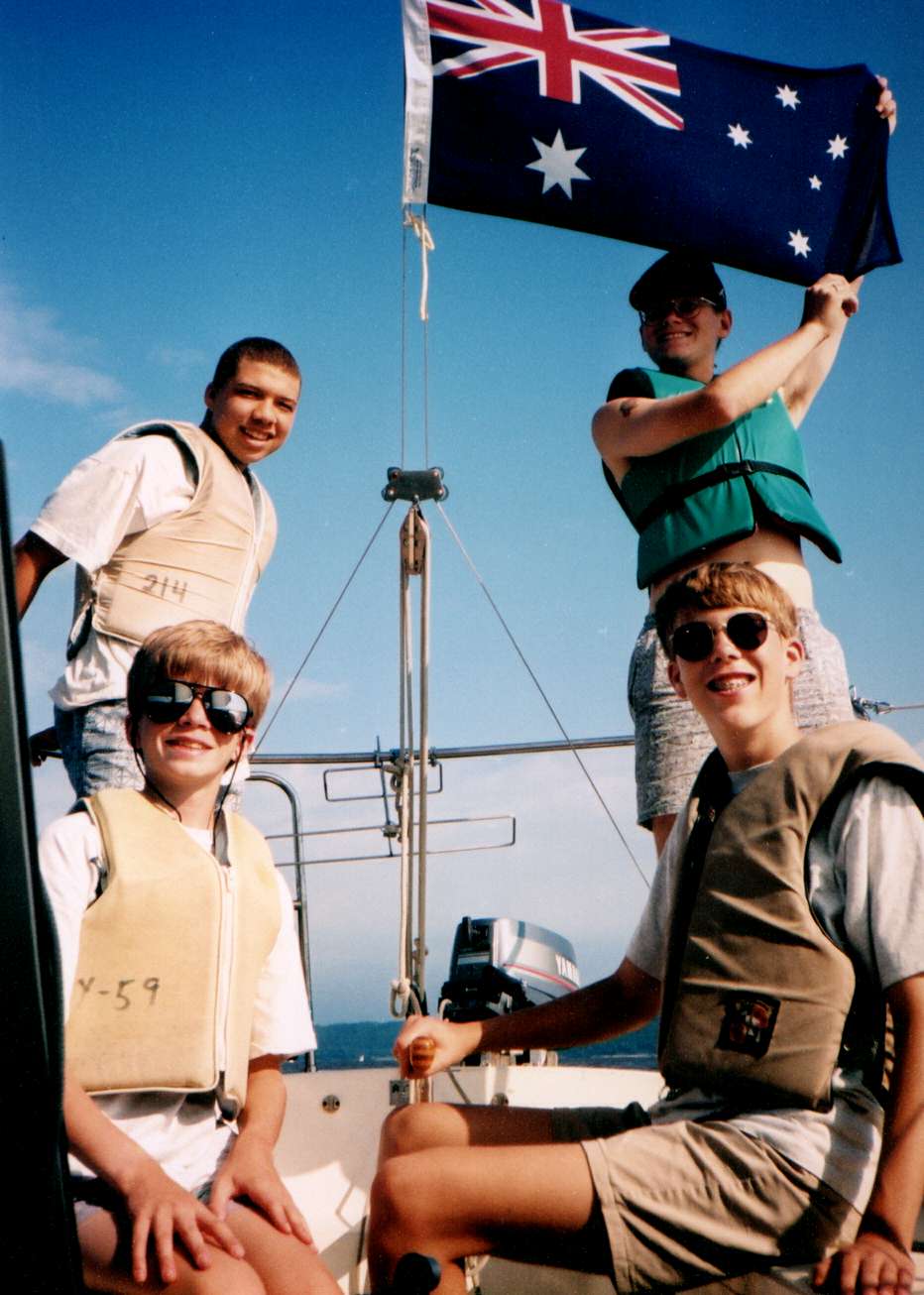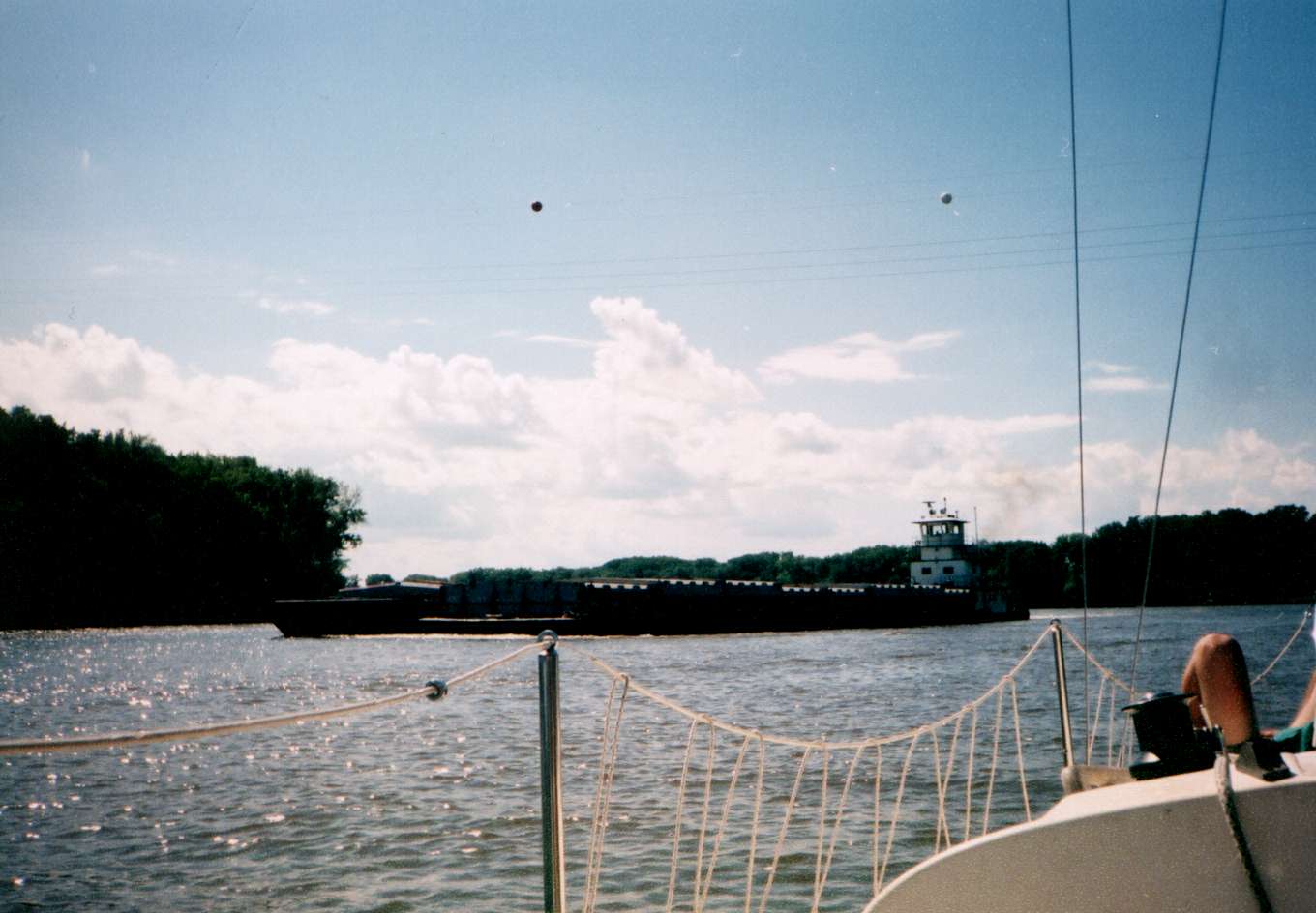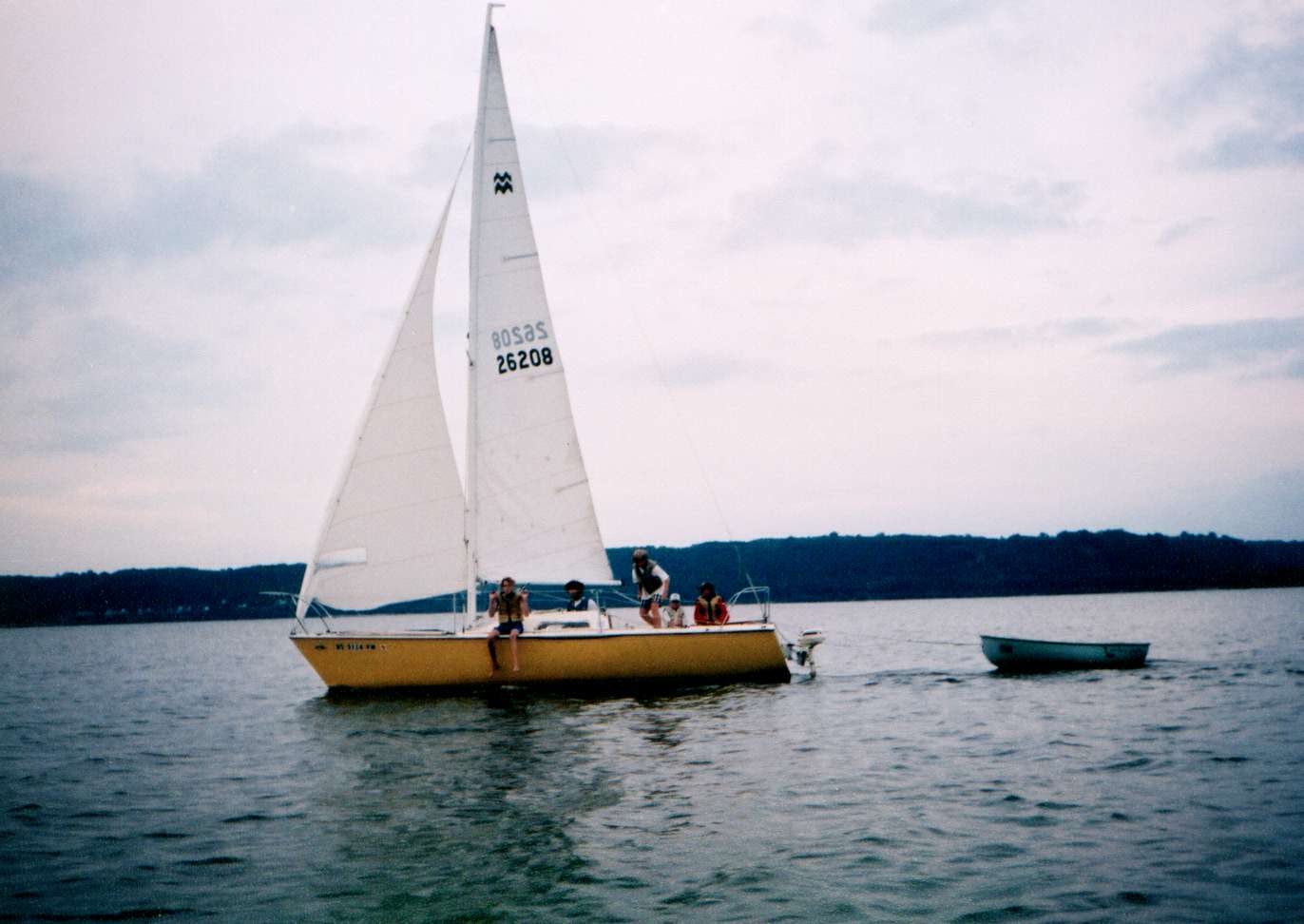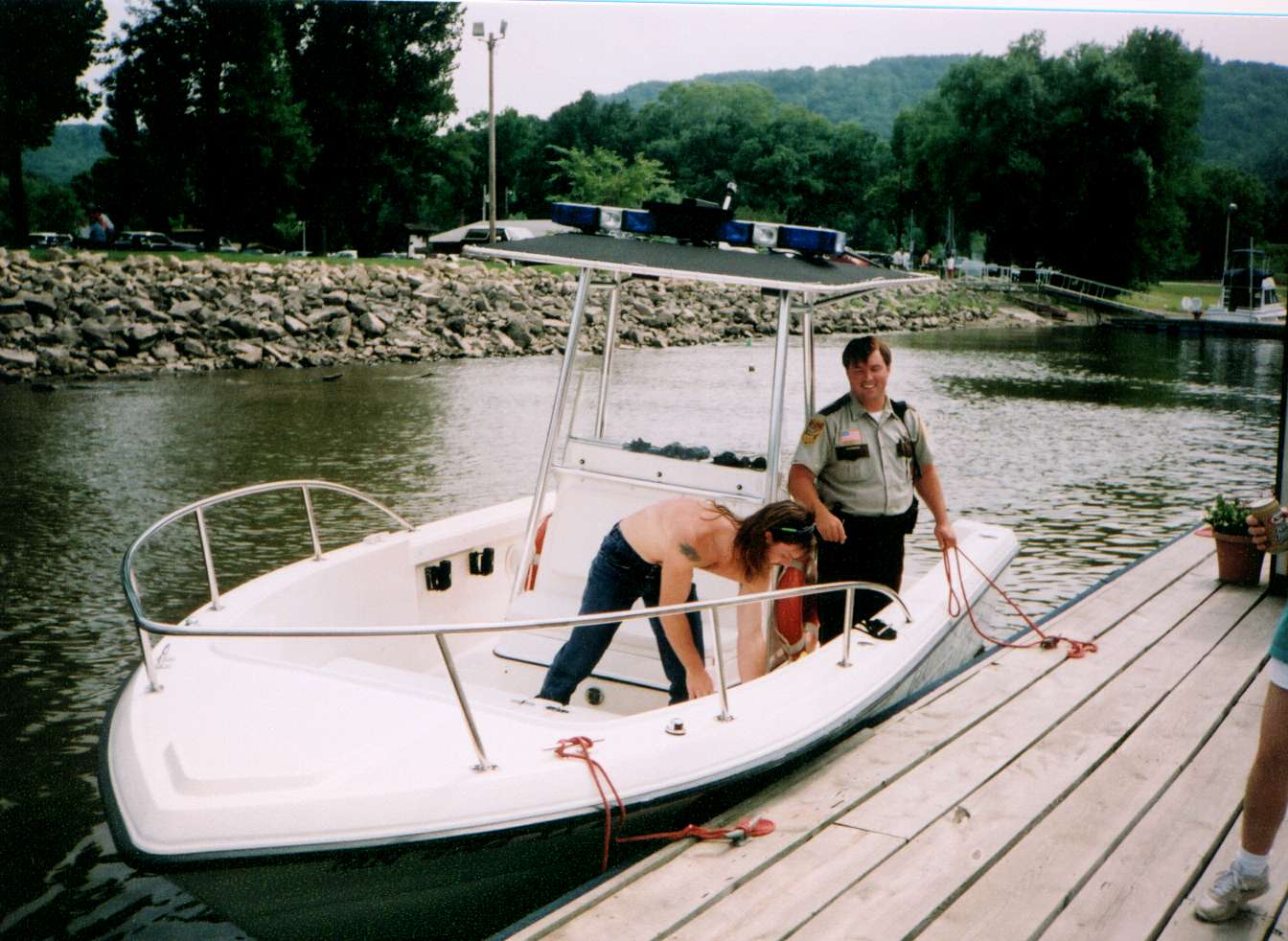
Mississippi Cruising
Along the “Big Muddy” the heartland of the United States, Michael Bastin led a voyage of discovery for a group of young Camp St. Croix men learning all about sailing.
by Michael Bastin
The wheels of the van hummed steadily as we traveled south toward Lake Pepin to collect the two yachts for our planned cruise back up the Mississippi and St. Croix Rivers to YMCA Camp St. Croix. Beside me was Paul, the camp sailing director, and behind us sat 10 teenage boys with minimal sailing experience. After arriving at YMCA Camp Pepin we listened to the horror stories from the all-girl crews who’d sailed the yachts down. They’d broken two of the three motors on the yachts and managed to spill fuel over their food. As a consequence they had been living on peanut butter sandwiches for the last two days.
Out on the lake a multitude of sailing vessels were enjoying the conditions. Lake Pepin is about 15 miles long and four miles wide, with waters deep enough for tugs and tows. Its shores are lined with many small towns and, at the height of summer, dense green foliage. The wind was from the south and gusting to 25 kts as we stowed all our equipment and rigged the boats.
 |
| Some of the Camp St. Croix campers on board the L’Equipe. |
Deciding not to fix the motors straight away, we raised our flags and set sail. My yacht, a Mirage 24 called “L’Equipe” (pronounced Le Keep) proudly displayed the Australian flag and the second yacht, a Kirby 25 called “Kirby”, had the Welsh flag hoisted. Most boats on the river run American flags of one type or another and our flags drew a lot of attention and comment during our time on the river. After a few tacking and gybing drills to get the boys used to the boats we turned and ran downwind at maximum speed.
At the northern end of the lake we met the first of many large barges which ply the mighty upper Mississippi River. They transport bulk goods, ranging from grain and fuel to gravel. Between four and twelve barge sections of different types are secured together and then pushed by a large powerful tug. The barges have complete right of way and at first sight they appear very hard to handle in narrow waterways. They are, however, very maneuverable and the pilots of the barges navigate the waterways (which at times are only marginally wider than the barges themselves) very successfully. As the lake began to close up and take a westerly direction, the winds started to shift and become erratic. At one point we had the two yachts, sailing parallel, about 25 feet apart, with one close-hauled on a starboard tack and the other running downwind. As it began to get dark we furled the jibs and sailed in close company, looking for a place to moor overnight. Unlike a lot of Australian waterways and rivers, the channel markers on the Mississippi aren’t lit, and as a result Kirby left the channel in the darkness and ran aground.
After a few minutes Paul had her free again and we moved to the other side of the channel, where the water was deeper, and rafted the yachts together for the night.
After eating and fixing the motors, we sat on deck and enjoyed a spectacular show as an electrical storm passed a few miles to the north of us. The sight of continuous lightning illuminating the sky over the land and reflecting off the water is one I won’t forget for a while. Next morning a surprise awaited us; the decks and rigging of both boats were covered in May Flies. Millions of these insects all hatch out at exactly the same time for some unknown reason, breed, lay their eggs, and then die. All of this happens in around a 24-hour period. Initially we thought they were all dead, but closer inspection revealed they were all stuck to the boats by the morning dew. As they started to dry they’d stand up and then, in waves, hundreds at a time, they’d launch into the air and travel with the wind.
Even early in the morning there were already a lot of other boats on the river, ranging in size from small dinghies, up to 40-foot cruisers. They were all very courteous and tended to slow down to reduce their wash, and also gave us plenty of seaway as they passed. Sailing against a fast current and strong headwind, we had plenty of time to enjoy the passing scenery. Hidden amongst the greenery and following the shoreline was a very busy railway line. Day and night, enormous freight trains would pass in one direction or the other, loudly sounding their airhorns as they passed the many crossings along the track.
Unfortunately the charts for the river are not all that accurate with regard to depth. This is partly caused by the numerous locks and dams along its length, which regulate the water level and cause it to rise and fall unpredictably. As well, the river is fast flowing and tends to change its bottom contours quite regularly. At the end of one tack we ran too close to a bank where there should have been deep water and came to a very sudden, but basically harmless stop.
 |
| A barge passing us down the Mississippi River. |
In one way it was fortunate as it gave me the chance to teach the boys how to free the keel by using the power of the wind to both tilt the yacht and drive it off the sandbar. In less than two minutes we were underway again and rapidly gaining on Kirby, which was waiting further upriver for us.
As we approached, Paul set his sails again and we followed in his wake. The Kirby had a deeper draft than the L’Equipe and I assumed if it didn’t run aground then my yacht should clear as well. How could I be wrong? Less than 10 minutes later I was high and dry again. This time, however, L’Equipe was well and truly stuck, and even using the wind, the engine, and all the boys hanging off the side, she wouldn’t budge an inch.
Lady Luck was smiling on us though, and within five minutes of deciding we’d need outside help a local police boat came along and asked if we needed assistance. We quickly tossed him a line and after he’d secured it to a stern cleat we made our first attempt. The officer gently took up the slack in the line and, with our motor at full power and sails set, he gunned the enormous twin outboards of his craft, but we didn’t budge. After spending some time convincing him that our yacht wouldn’t be damaged if he took a run up and tried to jerk us loose of the sand bank he agreed to try. Accompanied by the bellowing of the powerful motors on the back, the patrol boat surged forward, the line quickly taking up and stretching.
For a moment it looked like we were doomed to failure, then the yacht shifted and was snatched clear of the sandbar and back into one of the channels. Checking with the officer revealed the channel actually split in two at this point and boats regularly ran aground there.
We said our goodbyes and continued up the river for another two miles to one of the many marinas which dot the shores of the Mississippi and St. Croix rivers. As with all our maneuvers we came alongside using wind power only. In the interest of teaching the boys as much as possible about sailing in a limited time, the motors were only used in emergencies, or if the wind died completely.
After tying up to a pontoon, we topped up the fuel and water and then did some running repairs on the rigging. While there, we saw the police boat again. This time it was towing a power boat which had run out of fuel coming up river. A policeman has a busy life on this river!
The Mississippi River in the state of Minnesota meanders through the countryside, and you can’t sail for more than a mile without coming to a bend. The wind, however, tends to remain fairly constant from either up or down river and it’s channelled by the banks. As a result, when we left the marina we had a good tailwind and this held, even though, at times, our course changed up to 180 degrees.
Our planned destination for the overnight stop was Red Wing. It’s a largely industrial town and as we approached it the change from verdant undergrowth to crowded factory sites was totally unexpected. On arriving at Red Wing marina we discovered the yearly County Fair was in full swing and after mooring the yachts we all went ashore and explored the cultural delights of the American mid-west. The fair was like something from a film, with line dancing, games and competitions, lots of food and drink, and a country and western band. After a thoroughly enjoyable time, we returned to the yachts just in time to watch a breathtaking display of fireworks which just happened to be positioned directly over where we were anchored. An excellent way to finish a great day’s sailing!
Next morning we were up bright and early to get a good start on the day, only to find the river shrouded in mist, with not a breath of wind. Once again the outboards stirred into life and we motored out of the marina and headed upriver, leaving a subdued Red Wing behind us. By mid-morning the mist had burned off and we had our first sighting of Lock and Dam No. 3. After a short delay we were allowed to enter and in just a few minutes we’d risen two meters and we were motoring out the other side. The locks are very impressive and are built to accommodate the largest of the barges which ply the river.
 |
| The boys in control of the Kirby on the final leg. |
As a result the flotilla of small vessels which passed through with us seemed a bit insignificant compared to the size of the lock.
By mid-afternoon we’d reached the junction of the Mississippi and St. Croix rivers and we were quite surprised at the difference in water quality between the two. Where they come together there is a distinct line, with the muddy brown of the Mississippi on one side and the clear water of the St. Croix on the other. The water in the St. Croix looked so inviting after the Mississippi that we decided to moor and spend the rest of the day swimming and relaxing.
As night fell a light wind started to blow from the south and we decided to do some night sailing. The sky was clear and a full moon was on the rise, giving excellent visibility. We knew from past experience the water in the river was deep. At first the wind was intermittent and this gave us a good opportunity to show the boys how to read wind patterns on the water.
 |
| The friendly local constabulary assisted to get one boat off the mud. |
Then the wind picked up and as the boys worked in shifts sailing the yachts, we made good time and were within two hours of the camp when we anchored for the night.
| The L’Equipe and the Kirby rafted up at Prescott, Wisconsin. |
Everyone had worked hard the previous evening so we slept late the following morning and after a big breakfast we let the boys take complete control of handling and navigation of the yachts and had the two crews race each other all the way back to the camp. In a short time we were safely back and everyone was happy. The trip had taken four days and three nights and had been filled with new experiences for both myself and the boys. They learned a lot and progressed further along the path towards being competent sailors, and I was satisfied with everything we’d all achieved.
Michael Bastin is from Australia. He was sailing director at Camp St. Croix in Hudson, WI at the time of the story. He is now an ASA Instructor for Northern Breezes Sailing School, and a freelance writer living in Minneapolis, MN.